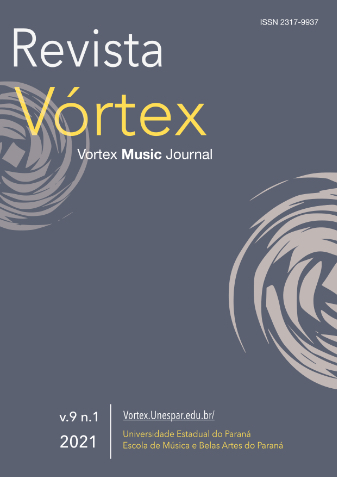Karen Tuttle's Coordination applied to the performance and interpretation of Edino Krieger's Brasiliana
DOI:
https://doi.org/10.33871/23179937.2021.9.1.13Palabras clave:
KarenTuttle's Coordination, Edino Krieger, Brasiliana, Viola Performance, Music PerformanceResumen
In challenging SPITZER’s (2009) proposition of absence of structure and balance (parataxis) within “Von deiner Güt’, o Herr und Gott”, from J. Haydn’s The Creation, the present a This article focuses on the application of Coordination, a set of principles and techniques developed by the late violist Karen Tuttle, as applied to the performance of Brasiliana for Viola and Strings by Edino Krieger. Coordination occurs in performance through specific physical motions of the performer’s body that connect the emotional and musical aspects of the interpretation. This study draws on interview content with Dr. Susan Dubois, Tuttle’s former teaching assistant at the Juilliard School of Music, and a leading exponent of her teaching. After a brief background on Tuttle ́s techniques and on the piece itself, annotated excerpts of the solo viola part are provided, with suggested interpretative markings applying these techniques. Article addresses contemporary analytical theories of form that may reveal exactly the opposite. The analytical framework used in the study was drawn from theoretical tools designed by CAPLIN (1998; 2001; 2009), HEPOKOSKI, and DARCY (2006) for the analysis of Classical form. This paper argues that tonal balance is a fundamental organizational device and serves as a structuring agent in the composition discussed. Moreover, the tonal balance featured in “Von deiner Güt’” illuminates the underlying structure of the textual narrative, thus rendering a stronger rhetorical appeal to the climactic moment in which it is inserted. The most salient significance of this research lies in its applicability to other cases of less strict formal structure that may be dismissed as parataxis while they, in fact, feature careful formal construction on the composer’s part.
Descargas
Citas
BARRETT, Henry. The Viola: Complete guide for teachers and students.2nd ed.Alabama: Universityof Alabama Press, 1978.BIAGGI, Emerson Luizde. Brazilian Art-Music in The Post-Nationalist Period: Three Compositions for Viola. Doctoral Dissertation. Santa Barbara: University of California Santa Barbara,1996.DANE, Matthew. Coordinated Effort: A Study of Karen Tuttle's Influence on Modern Viola Teaching. Doctoral dissertation. Houston: Rice University, 2002.DEW, Robert. In Response to Instinct –Karen Tuttle's Insights into the Coordinated Action –its Mechanisms, Articulation, and Prerequisites. The Strad, 104, no. 1241,p. 835-838, September 1993.PIERMARTIRI, Leonardo. Interview with Dr. Susan Dubois. University of North Texas, Denton-TX, November 4th, 2020. Entrevista. PAZ, Ermelinda. Edino Krieger: Compositor, Produtor Musical, Crítico. Rio de Janeiro: SESC Departamento Nacional, 2012. Vol 2.RODLAND, Carol. Master Class: In Honor of Karen Tuttle as She Retires.American String Teacher, 54, n.2, p. 45-47, May 2004.SANDER, Amber. Performer's Guide to the Execution and Application of Karen Tuttle's Coordination, as Applied to Ernest Bloch's Suite Hébraïque. Doctoral dissertation. Denton:University of North Texas,Denton, 2013.REITER, Emmanuella. Karen Tuttle's Heritage: the theory and practiceof co-ordination. Boston: Allegra Print & Imaging, 2008.RITSCHER, Karen. An Interview with Karen Tuttle. American String Teacher,Fairfax-VA, v. 43,n.4, p. 86-91, Autumn 1993.WEINBERGER, Rozanna. Body and Soul: Teacher Karen Tuttle Reveals How She Helps Students Play Without Pain. Strings,13, no.4,p.66-70, December 1998.
Descargas
Publicado
Cómo citar
Número
Sección
Licencia
Derechos de autor 2021 Leonardo Piermartiri, Daphne Capparelli Gerling

Esta obra está bajo una licencia internacional Creative Commons Atribución 4.0.
Los autores conservan los derechos de autor y conceden a la revista el derecho de primera publicación, con el trabajo simultáneamente bajo la licencia Creative Commons Attribution Licence que permite compartir el trabajo con reconocimiento de autoría y publicación inicial en esta revista.






